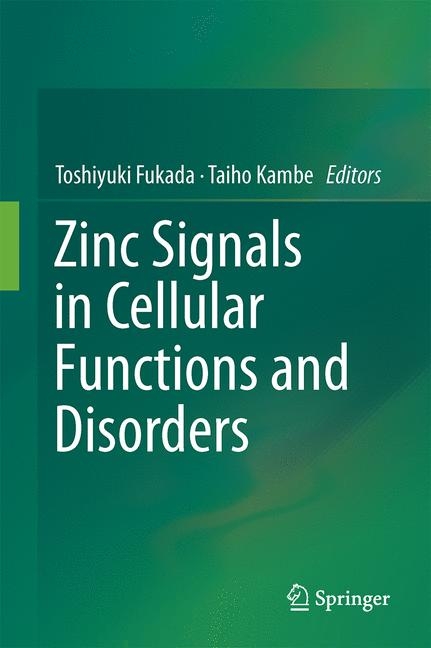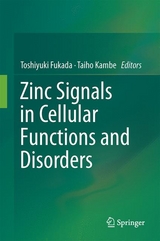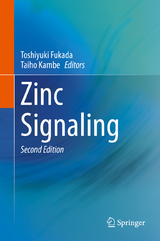Zinc Signals in Cellular Functions and Disorders
Springer Verlag, Japan
978-4-431-55113-3 (ISBN)
- Titel erscheint in neuer Auflage
- Artikel merken
This book describes the crucial role of "zinc signals" in biological processes on a molecular and physiological basis, discussing future directions and questions underlying this unique phenomenon. To accomplish this, a group of worldwide leaders in the field, who have made outstanding contributions, overview zinc signals from a professional standpoint. Zinc plays an indispensable role in various cellular processes. It regulates a great number of protein functions including transcription factors, enzymes, adapters, and growth factors as a structural or catalytic factor or both. Recently, another function of zinc has received extensive interest and attention because of its potential importance as a signaling mediator. Zinc plays a dynamic role as an intracellular and extracellular signaling factor and thus regulates cellular signaling pathways, which enables communication between cells, conversion of extracellular stimuli to intracellular signals, and control of various intracellular events. These functions of zinc have become recognized as “zinc signals,” which play critical roles in physiology, and therefore their imbalance can cause a variety of problems with regard to human health. Because the notion of zinc signals is quite new and no integrative review books focusing on them have yet been published, we believe this book will provide very timely information on the subject and thus should be of importance and interest to a wide range of readers.
Foreword.- Preface.- 1 Introduction - “Zinc Signaling”: The Blossoming Field of Zinc Biology (Taiho Kambe).- 2 Molecular Aspects of Zinc Signals (Wolfgang Maret).- 3 Zinc Transport Proteins and Zinc Signaling (Taiho Kambe, Tokuji Tsuji, and Kazuhisa Fukue).- 4 Oxidative Stress and Neuronal Zinc Signaling (Hirokazu Hara and Elias Aizenman).- 5 Zinc Signaling by “Zinc Wave” (Keigo Nishida and Satoru Yamasaki).- 6 The Zinc Sensing Receptor, ZnR/GPR39: Signaling and Significance (Michal Hershfinkel).- 7 Genetically-Encoded Fluorescent Probes for Intracellular Zn2+ Imaging (Anne M. Hessels and Maarten Merkx).- 8 Zinc Signal in Brain Functions (Atsushi Takeda).- 9 The Clinical Implications of Impaired Zinc Signalling in the Brain (Sara M. Hancock, Ashley I. Bush, and Paul A. Adlard).- 10 Zinc Signals in Immunology (Lothar Rink and Martina Maywald).- 11 Zinc Signal in Inflammation (Ming-Jie Liu and Daren L. Knoell).- 12 Zinc Signal in Growth Control and Bone Diseases (Toshiyuki Fukada, Shintaro Hojyo, and Bum-Ho Bin).- 13 Zinc and its Role in the Pathogenesis of Type 2 Diabetes (Yoshio Fujitani, Motoyuki Tamaki, Ayako Fukunaka, and Hirotaka Watada).- 14 Zinc Signalling and Cancer (Thirayost Nimmanon and Kathryn M. Taylor).- 15 Zinc as a Key Meiotic Cell Cycle Regulator in the Mammalian Oocyte (Ru Ya, Emily Que, Thomas V. O’Halloran, and Teresa K. Woodruff).- BM Future Perspectives (Toshiyuki Fukada).- Index.
| Zusatzinfo | 10 Tables, black and white; 51 Illustrations, color; 12 Illustrations, black and white; XII, 343 p. 63 illus., 51 illus. in color. |
|---|---|
| Verlagsort | Tokyo |
| Sprache | englisch |
| Maße | 155 x 235 mm |
| Gewicht | 7209 g |
| Themenwelt | Studium ► 1. Studienabschnitt (Vorklinik) ► Physiologie |
| Naturwissenschaften ► Biologie ► Mikrobiologie / Immunologie | |
| Naturwissenschaften ► Biologie ► Zellbiologie | |
| Schlagworte | Cancer • immunity • inflammation • Metallothionein • Physiology • Zinc receptors • Zinc signals • Zinc transporters |
| ISBN-10 | 4-431-55113-1 / 4431551131 |
| ISBN-13 | 978-4-431-55113-3 / 9784431551133 |
| Zustand | Neuware |
| Informationen gemäß Produktsicherheitsverordnung (GPSR) | |
| Haben Sie eine Frage zum Produkt? |
aus dem Bereich





